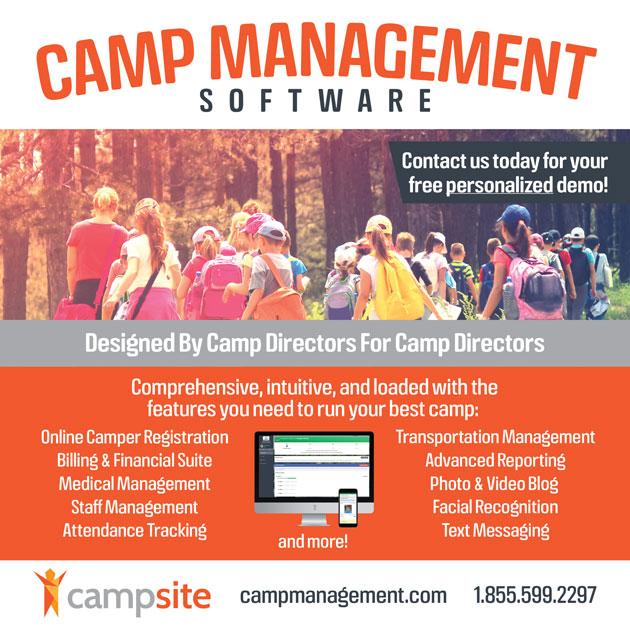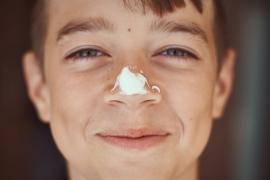How did it go? After 2020's "different" summer, we stepped into 2021 with hope. More camps opened, some staff were COVID-19 immunized, and protective behaviors — such as masks, physical distancing, handwashing, and cohorting — changed some camp practices. Those changes also provided assurance that a COVID outbreak at camp would be minimized, if not eliminated. In addition, camp professionals became more attentive to camper and staff mental, emotional, social health (MESH) needs as we navigated being together again.
It's time to assess our practices with an eye to the future. How did the summer go as we "did camp" in a COVID world? More importantly, what practices implemented because of the pandemic might stick beyond the summer because those practices improved the camp experience? This content presents topics to consider. Use the topic's preceding box to check areas that went well — or are going well — for you and your camp community. Identify improvements for topics that are unchecked. Finally, consider practices that ought to remain part of camp's routine as we step into tomorrow with an improved camp experience in mind.
Camper and staff policies were adapted to allow flexibility in the camp's response to COVID and written so the policies would apply to any communicable disease outbreak. Whether in print or online, these policies were available prior to registration/job application so individuals were well aware of the camp's stance and practices, allowing them to make decisions that complemented their personal comfort level.
NOTE: This includes the camp's immunization policy. Thoughtfully consider your stance regarding immunizations and provide a policy that reflects that stance. Make it known to campers, parents, and staff before they make their camp decision. In so doing, consider the distinction between what is required for camper (client) participation verses what's needed for staff (employees). Provide the name/contact information for a camp professional who can answer questions that may arise.
Pre-arrival screening: campers and staff arrived with completed pre-arrival screening forms and/or results from their COVID tests. Give yourself extra credit if that screening included assessment of health-promoting behaviors like tracking the amount of nighttime sleep and daily exercise that increased the person's heart rate.
Individuals were cohorted upon arrival. To limit the potential of COVID or other communicable diseases getting spread to the entire camp population, campers and staff "did camp" in small groups until threat of illness could be minimized, if not eliminated. Cohorted groups were subsumed into camp routine in a way that creatively normalized that grouping (e.g., doing skits, signing up for activities, creating a group handshake or cheer, reading together).
Staff were educated about, recognized, and acted upon camper MESH behavior(s) that indicated a problem. Typically introduced during staff orientation, all staff not only practiced appropriate interaction with campers, but also noted campers who, through their behavior, indicated something was wrong. This included campers who changed their participation practice, had restless sleep, showed an altered eating pattern, and/or emotionally became too quiet, too quick to tears, or responded with anger out of place for the situation. Staff members recognized that behavior and took appropriate action (Ditter, 2021).
Access to a MESH professional was available before and during camp. Whether at camp or not, this professional helped camp staff identify and respond to campers' MESH concerns, including those associated with COVID (e.g., fear of interacting with unfamiliar people; anxiety about touching and being touched by others; navigating personal COVID experiences such as the death of a loved one). While COVID has been recognized as a shared trauma, responses to that trauma have varied from person to person. Each reaction was acknowledged and appropriately respected/addressed. For campers, this included being able to talk about concerns with a trusted camp staff member (e.g., MESH professional, cabin/group counselor) who, in turn, understood their limitations and referred people when care fell outside their scope of responsibility. A similar support system was in place for staff who recognized they, too, were navigating MESH concerns (Thurber, 2021).
Physical ability may have deteriorated because of a prolonged, sedentary, COVID lifestyle. Consequently, camp practices were adjusted to recognize, assess, and adapt accordingly. This may have meant rebuilding endurance for activities like swimming, gradually increasing the weight of carried loads (including arrival day trunks and suitcases), and/or adjusting rest, nutrition, and hydration to complement changes in physical activity. In particular and because of its insidious nature, the impact of fatigue was monitored whether it stemmed from physical activity or emotional stressors.
Protective communicable disease behaviors were practiced throughout the camp season. Exactly what nonpharmaceutical interventions (NPIs) were used might vary from camp to camp, but strategies such as frequent handwashing, cough/sneeze etiquette, physical distancing, and selective use of masks limited not only threat from COVID, but also other communicable illnesses. Such behaviors should become routine expectations because there will eventually be another communicable disease outbreak. It may not be a pandemic, but any camp that's coped with incidents like norovirus understands how easily and quickly such outbreaks can happen.
The camp population enjoyed limited exposure to noncamp people. Whether a day or resident camp, campers and staff interacted with individuals for whom the camp had some assurance that they'd not introduce illness. This included making a distinction between appropriately immunized participants and those without that protection, something especially important with regard to staff time-off. It also addressed events such as visiting day, a time when others spend time physically at camp and/or with campers.
Activities were done outdoors. Anything that could be done outside took place outdoors, including delivery of health care and meals. Indoor time was limited to necessary tasks and minimized gatherings of large groups. Rainy day activities made use of previously cohorted groups (e.g., cabin groups; small day camp groups) to minimize exposure potentials. Activities that could not be done outside were either not offered or limited to cohorted groups.
The camp's injury-illness data indicated a healthier camp experience. A benefit of communicable disease control is a healthier experience for campers and staff (Garst & Gaslin, 2021). While COVID may have been the recent focus, commonly occurring illnesses such as colds, strep throat, and impetigo would also benefit from the same control measures. That impact will show in the camp's injury-illness data set. Did it?
Camp activities incorporated and recognized learning. Given widespread concern over COVID's learning loss — "seat time" in schools — camp became more attentive to its learning opportunities and pointed these out to campers, parents, and staff. Whether that was via formal learning, such as reading time, or more informal experiences — like using geometry principles in archery or Newton's Laws of Motion to swim — the camp program identified these and capitalized on them. Also consider the "softer" skills associated with personal interactions. Indeed, cooperative and collaborative skills may be more valuable than simply "knowing" something.
Parent calls reflected support for camp's protective approach to communicable diseases. Whether via phone, email, or in-person conversations, parents/custodial adults expressed support for camp's communicable disease control practices, knew who to contact when questions arose, and were able to discuss dissenting perspectives with an informed and skilled camp professional.
External entities were informed about and supported the camp's communicable disease policies and practices. Entities such as the Department of Health, local medical professionals, the camp's clinic and hospital, and the camp's liability insurance carrier were appropriately consulted and knew about the camp's practices (i.e., had copies of policy statements, practice guidelines).
Camp leaders maintained open communication with their internal and external audiences and invited people with ideas to share them. Often assessed via post-camp surveys, various groups knew that their comments were both welcomed and heard. Ideas for improvements were especially invited, while concerns were addressed in a timely manner.
Opportunity to "do camp" remotely was available. Everyone may not be able to physically attend camp. Perhaps they're immune-compromised, someone at home is put at-risk if they attend, or the family schedule didn't match camp sessions. Consequently, options to participate in camp in other ways were available. COVID enabled some of this during summer 2020. Those lessons ought to be retained, appropriately modified, and utilized while we continue to extol the value of an in-person camp experience.
The pandemic experience brought significant challenges to the camp experience. But it also introduced opportunity to change the way we've traditionally done camp. As COVID wanes, some coping strategies may also disappear. But some will stick — especially those learned about managing a communicable disease outbreak. The H1N1 (swine flu) outbreak in 2009 introduced control measures that many thought would never be forgotten — but they were. We cannot let surveillance and control measures relax or disappear this time, because the next outbreak is possible whenever we bring groups of people together, something the camp experience delightfully does over and over. Consequently, thoughtfully consider what control strategies should be institutionalized for your own program and work to accomplish that. Let's minimize the risk exposure from all communicable diseases.
Linda Ebner Erceg's (RN, MS, PHN) many years of year-round work as a camp professional, leadership in the Association of Camp Nursing, and participation in ACA initiatives contribute to her Camping Magazine content. She facilitates the Healthy Camps Committee, a collaboration between ACA and ACN, while also enjoying a robust speaking and consulting career from her Bemidji, Minnesota, home base. These activities help make her personal motto, "Healthier Camping for All," a growing reality. Contact Linda via email at [email protected].
References
- Ditter, B. (2021). Working with mental, emotional, and social health issues of campers in the age of the coronavirus pandemic. COVID-19 and Communicable disease guide. Association of Camp Nursing: March 2021; 49-60.
- Garst, B.A., and Gaslin, T. (2021). Camp utilization of nonpharmaceutical interventions (NPIs) in the Summer of 2020 following the onset of COVID-19. COVID-19 and Communicable disease guide. Association of Camp Nursing: March 2021; 4-12.
- Thurber, C.A. (2021). Supporting staff mental, emotional, and social health (MESH) at youth summer camps. COVID-19 and Communicable disease guide. Association of Camp Nursing: March 2021; 61-67.


